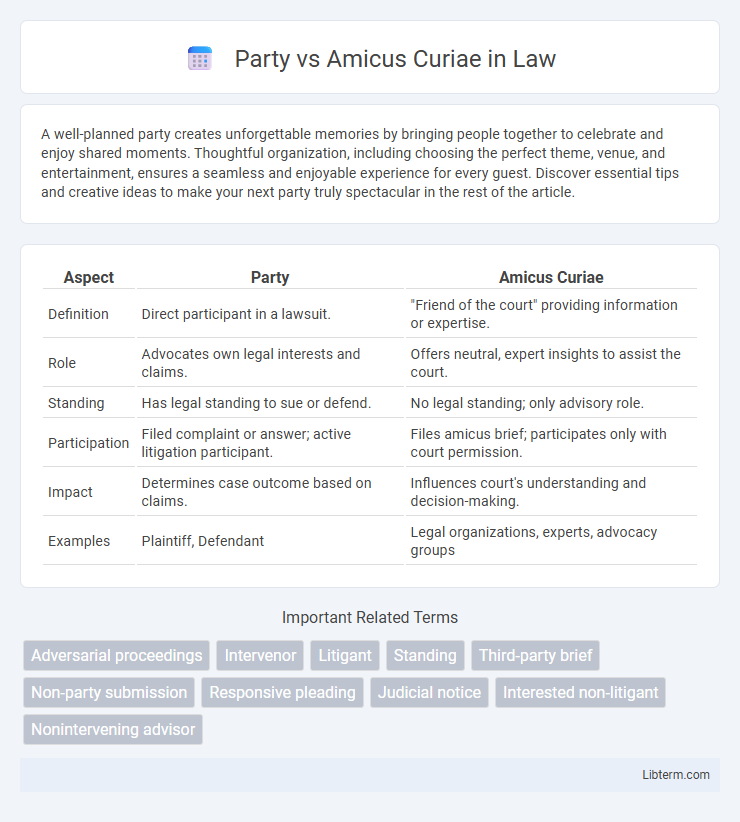A well-planned party creates unforgettable memories by bringing people together to celebrate and enjoy shared moments. Thoughtful organization, including choosing the perfect theme, venue, and entertainment, ensures a seamless and enjoyable experience for every guest. Discover essential tips and creative ideas to make your next party truly spectacular in the rest of the article.
Table of Comparison
| Aspect | Party | Amicus Curiae |
|---|---|---|
| Definition | Direct participant in a lawsuit. | "Friend of the court" providing information or expertise. |
| Role | Advocates own legal interests and claims. | Offers neutral, expert insights to assist the court. |
| Standing | Has legal standing to sue or defend. | No legal standing; only advisory role. |
| Participation | Filed complaint or answer; active litigation participant. | Files amicus brief; participates only with court permission. |
| Impact | Determines case outcome based on claims. | Influences court's understanding and decision-making. |
| Examples | Plaintiff, Defendant | Legal organizations, experts, advocacy groups |
Understanding the Term “Party” in Legal Context
In legal proceedings, a "party" refers to an individual or entity directly involved in a lawsuit, bearing rights and obligations within the case. Parties include plaintiffs, defendants, appellants, and appellees who actively participate by presenting evidence and arguments to influence the court's decision. Unlike an amicus curiae, who offers information or expertise without direct stake in the outcome, parties have a vested interest in the legal controversy and the enforcement of the judgment.
Defining Amicus Curiae: Friend of the Court
An amicus curiae, or friend of the court, is a non-party entity that offers information, expertise, or insight relevant to a legal case to assist the court in making a well-informed decision. Unlike parties directly involved in the litigation, amici curiae do not have a stake in the outcome but seek to provide an impartial perspective that could affect the case's broader implications. Courts often welcome amicus briefs in complex cases to illuminate legal, social, or economic issues beyond the factual record presented by the parties.
Legal Roles and Responsibilities: Party vs Amicus Curiae
A party in a legal case has direct involvement and is responsible for presenting evidence, arguing claims, and seeking a judgment that affects their rights or interests. An amicus curiae, or "friend of the court," provides information, expertise, or insights relevant to the case but does not represent any party or have a stake in the outcome. The party drives the litigation process, while the amicus curiae aids the court by offering impartial perspectives to assist in legal decision-making.
Standing: Rights to Initiate or Join Litigation
Party plaintiffs possess direct standing, granting them the legal right to initiate or join litigation based on a concrete and particularized injury. Amicus curiae, or "friend of the court," lack standing to initiate lawsuits but may participate by submitting briefs to offer expertise or perspective relevant to the case. Courts allow amicus curiae involvement solely to assist in decision-making without conferring any procedural rights to litigate or intervene as a party.
Scope of Participation in Court Proceedings
Parties actively participate in court proceedings with full rights to present evidence, examine witnesses, and make legal arguments directly affecting the outcome of the case. Amicus curiae, or "friends of the court," provide information, expertise, or insight relevant to the case but do not engage in procedural activities such as presenting evidence or examining witnesses. The scope of participation for parties is comprehensive and central to litigation, while amicus curiae involvement is limited to submitting briefs or oral arguments intended to assist the court's understanding of broader implications.
Interest Representation: Direct vs Indirect Involvement
Parties in a lawsuit have direct involvement, representing their own legal interests and seeking specific outcomes from the court. Amicus curiae, or "friend of the court," provide indirect involvement by offering expert opinions or information to assist the court in understanding broader implications without being a direct litigant. This distinction highlights parties' active advocacy versus amicus curiae's supportive role in influencing judicial decisions.
Submission Rights: Pleadings, Evidence, and Arguments
Parties have the explicit right to submit pleadings, evidence, and legal arguments directly affecting the case's outcome. Amicus curiae, or "friend of the court," may submit briefs or arguments only with the court's permission, offering specialized information or perspectives without being directly involved as litigants. Unlike parties, amici cannot introduce new evidence or participate in trials but influence decisions through persuasive legal insights.
Impact on Judicial Decision-Making
Parties directly involved in a case present evidence and arguments that fundamentally shape judicial decision-making through their vested interests and factual contributions. Amicus curiae briefs provide courts with specialized knowledge, broader perspectives, or societal implications beyond the parties' positions, influencing judges by supplementing the record with expert insights. The combined input from parties and amici curiae enriches the deliberative process, but parties generally hold greater sway due to their direct stake and procedural rights in the litigation.
Limitations and Restrictions for Parties and Amici
Parties in a lawsuit have direct stakes and are bound by procedural rules such as filing deadlines, evidence limitations, and the full scope of liability. Amici curiae, or "friends of the court," face restrictions including the need for court permission to file briefs, limits on addressing new evidence, and constraints to purely legal arguments without being direct litigants. Both entities must adhere to court-specific rules that balance access to influence judicial decisions with maintaining procedural fairness and efficiency.
Comparative Analysis: Benefits and Drawbacks
Party litigants directly influence case outcomes through active participation and control over legal strategy, benefiting from comprehensive evidence presentation but facing higher costs and procedural burdens. Amicus curiae, or "friend of the court," offers specialized knowledge and broader perspectives without the adversarial constraints, enhancing judicial decision-making yet lacking direct control and risking limited impact. The party system prioritizes vested interests and full procedural rights, while amicus curiae emphasizes impartial expertise and supplementary information, each with distinct strategic and practical advantages.
Party Infographic

 libterm.com
libterm.com